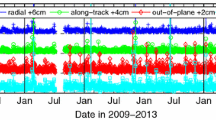Abstract
The European Space Agency’s Gravity field and steady-state ocean circulation explorer mission (GOCE) was launched on 17 March 2009. As the first of the Earth Explorer family of satellites within the Agency’s Living Planet Programme, it is aiming at a better understanding of the Earth system. The mission objective of GOCE is the determination of the Earth’s gravity field and geoid with high accuracy and maximum spatial resolution. The geoid, combined with the de facto mean ocean surface derived from twenty-odd years of satellite radar altimetry, yields the global dynamic ocean topography. It serves ocean circulation and ocean transport studies and sea level research. GOCE geoid heights allow the conversion of global positioning system (GPS) heights to high precision heights above sea level. Gravity anomalies and also gravity gradients from GOCE are used for gravity-to-density inversion and in particular for studies of the Earth’s lithosphere and upper mantle. GOCE is the first-ever satellite to carry a gravitational gradiometer, and in order to achieve its challenging mission objectives the satellite embarks a number of world-first technologies. In essence the spacecraft together with its sensors can be regarded as a spaceborne gravimeter. In this work, we describe the mission and the way it is operated and exploited in order to make available the best-possible measurements of the Earth gravity field. The main lessons learned from the first 19 months in orbit are also provided, in as far as they affect the quality of the science data products and therefore are of specific interest for GOCE data users.
Similar content being viewed by others
References
Andreis D, Canuto E (2005) Drag-free and attitude control for the GOCE satellite. Decision and control, 2005 and 2005 European Control Conference. CDC-ECC’05. 44th IEEE Conference on (November 30), pp. 4041–4046. doi:10.1007/s10291-008-0094-z
Bock H, Jäggi A, Meyer U, Visser P, van den IJssel J, van Helleputte T, Heinze M, Hugentobler U (2011) GPS-derived orbits for the GOCE satellite. J Geod (this issue). doi:10.1007/s00190-011-0484-9
Cesare S (2008) Performance requirements and budgets for the gradiometric mission, 4th edn. Technical report, Thales Alenia Space. http://earth.esa.int/goce, http://earth.esa.int/category/index.cfm?fcategoryid=42&S_ID=37
Drinkwater M, Floberghagen R, Haagmans R, Muzi D et al (2003) GOCE-ESA’s first Earth Explorer core mission. Space Sci Rev 108(1): 419–432. doi:10.1023/A:1026104216284
ESA (1999) Reports for mission selection: the four candidate earth explorer core missions: GOCE ESA-SP 1233
Frommknecht B, Lamarre D, Bigazzi A, Meloni M, Floberghagen R (2011) GOCE Level 1b Data Processing. J Geod (this issue)
Steiger Ch, Pineiro J, Emanuelli PP (2010) Operating GOCE, the European Space Agency’s Low-flying Gravity Mission. Paper presented at the 2010 SpaceOps conference in Huntsville, Alabama. (February 27)
Tapley B, Bettadpur S, Ries J, Thompson P, Watkins M (2004) GRACE measurements of mass variability in the Earth system. Science (New York NY) 305(5683): 503–505. doi:10.1126/science.1099192
Touboul P (2003) Microscope instrument development, lessons for GOCE. Space Sci Rev 108(1): 393–408. doi:10.1023/A:1026152114467
Touboul P (2004) In orbit nano-g measurements, lessons for future space missions. Aerosp Sci Technol 8(5): 431–441. doi:10.1016/j.ast.2004.01.006
Author information
Authors and Affiliations
Corresponding author
Additional information
This article has been written for the special issue on the GOCE mission of the Journal of Geodesy.
An erratum to this article can be found at http://dx.doi.org/10.1007/s00190-012-0541-z.
Rights and permissions
About this article
Cite this article
Floberghagen, R., Fehringer, M., Lamarre, D. et al. Mission design, operation and exploitation of the gravity field and steady-state ocean circulation explorer mission. J Geod 85, 749–758 (2011). https://doi.org/10.1007/s00190-011-0498-3
Received:
Accepted:
Published:
Issue Date:
DOI: https://doi.org/10.1007/s00190-011-0498-3




